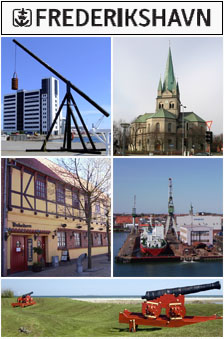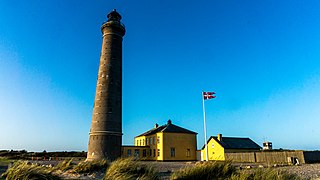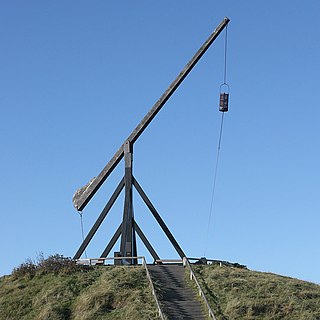
Frederikshavn is a Danish town in Frederikshavn municipality, Region Nordjylland, on the northeast coast of the Jutland peninsula in northern Denmark. Its name translates to "Frederik's harbor". It was originally named Fladstrand.

Skagen is Denmark's northernmost town, on the east coast of the Skagen Odde peninsula in the far north of Jutland, part of Frederikshavn Municipality in Nordjylland, 41 kilometres (25 mi) north of Frederikshavn and 108 kilometres (67 mi) northeast of Aalborg. The Port of Skagen is Denmark's main fishing port and it also has a thriving tourist industry, attracting 2 million people annually.

Vendsyssel is the northernmost traditional district of Denmark and of Jutland. Being divided from mainland Jutland by the Limfjord, it is technically a part of the North Jutlandic Island, but the name often used informally for the entire island. Vendsyssel is part of the North Denmark Region.

Grenen is a long sandbar spit at Skagen Odde, north of the town of Skagen.

The Kullen Lighthouse is an operational lighthouse in Scania, located by the mouth of Öresund, at the point of Kullaberg peninsula, in Höganäs, on the south-west coast of Sweden. Kullen is one of the most prominent landmarks along the Swedish coastline, and with its 1000 Watt electric bulb in a huge lenshouse, also the most powerful lighthouse in Scandinavia, overlooking one of the world's most heavily traveled waters.

Skagen railway station is the main railway station serving the town of Skagen in Vendsyssel, Denmark.

Frederikshavn railway station is a railway station serving the town of Frederikshavn in Vendsyssel, Denmark. It is located in central Frederikshavn, situated between the town centre and the Port of Frederikshavn, and immediately adjacent to the Frederikshavn bus station.

Frederikshavnsvej railway halt is a railway halt serving the western part of the town of Skagen in Vendsyssel, Denmark.

The Vendsyssel railway line is a 80.7 km (50.1 mi) long standard gauge single track railway line in Denmark which runs through the historical region of Vendsyssel between Aalborg and Frederikshavn in North Jutland. It constitutes the northernmost part of Den Østjyske Længdebane, the through route through the Jutland Peninsula from Padborg to Frederikshavn.

Hammeren Lighthouse is located on the Hammeren peninsula on the northwestern tip of the Danish island of Bornholm.

Skagen Odde, also Skagens Odde, sometimes known in English as the Scaw Spit or The Skaw, is a sandy peninsula which stretches some 30 km (19 mi) northeast and comprises the northernmost area of Vendsyssel in Jutland, Denmark.

Ulrik Adolph Plesner, usually known as Ulrik Plesner was an innovative Danish architect who designed in a National Romantic style at the beginning of the 20th century. He is remembered in particular for his influence on the style of architecture practiced in Skagen in the north of Jutland.

Højen or Gammel Skagen on the west side of Skagen Odde is an old fishing community which now forms part of the town of Skagen in the far north of Jutland, Denmark.
Ella Christine Heide, née Brodersen, was a Danish painter who from 1908 painted in Skagen in the far north of Jutland.
Skagen Festival is Denmark's oldest music festival having been held each summer since 1971. The annual event takes place on a number of stages in Skagen in the far north of Jutland over the first weekend of July.

Skagen Lighthouse, also known as Skagen's Grey Lighthouse, is an active lighthouse 4 km (2.5 mi) northeast of Skagen in the far north of Jutland, Denmark. Designed by architect Niels Sigfred Nebelong, it was brought into operation on 1 November 1858.

Skagen's Vippefyr is a navigational light mechanism located in Skagen in the far north of Jutland. The original vippefyr, the first of its kind, was built in 1627. A faithful copy now stands on the same site. It replaced an earlier parrot light (papegøjefyr) and served until 1747 when the White Lighthouse was brought into operation.

Nakkehoved Lighthouse was originally the name for two individual lighthouses above the namesake Nakkehoved cliffs, between Gilleleje and Hornbæk, approximately 40 km north of Copenhagen, Denmark. Since the eastern lighthouse was decommissioned in 1898, the name Nakkehoved lighthouse has come to refer to only the western tower, which is still operational. The eastern lighthouse was listed on the Danish registry of protected buildings and places in 1976. The western lighthouse was also listed on the registry in 2002.

A fire basket is an iron basket in which wood can be burned to make a bonfire. Fire baskets have been used since antiquity mainly to illuminate and heat rooms. Today, they are most often used in outdoor garden area as an outdoor heater or grill. The fire basket primarily is used to contain firewood, or another fuel, and is meant to offer fire protection.


















